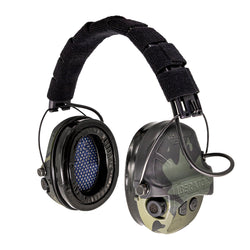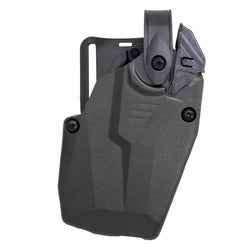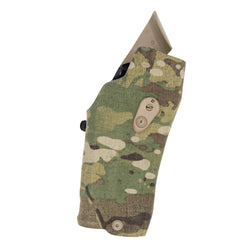Tom Marshall has released his first novel, Close and Destroy. I’m writing about it here for a number of reasons, chief of which is that I think a lot of you CADRE Dispatch readers will enjoy it. I certainly did. The gunplay is good, the action is well-written, the weapons are utilized realistically, and the tactics are as close to what Global War on Terror (GWOT) speartip types use as is possible to put in a novel. Maybe even more modern that.
Also, many of you probably already know Tom’s work from several admired industry publications (so you’ll recognize the name), and he’s my friend. You’ll want to keep that in mind while you read this, but also know that I’ll be as equitable as I can in my review.
Close and Destroy
You’ll hear the rounds when they go loud.
Close and Destroy is available in multiple formats. I originally read it on Kindle, but it has since become available on paper, in Amish/Mennonite fashion, and in audiobook format. The title references Marine Corps Reference Publication 3-10A.4, Marine Rifle Squad, which reads in part,
“The mission…is to locate, close with, and destroy the enemy by fire and maneuver, or repel the enemy’s assault by fire and close combat.”
Although the protagonists of the book are all Private Military Company (PMC) contractors working for the fictitious company Windsor Kraft Strategies in the equally fictional country of Daristan. Daristan is a make-believe nation, but its terrain, troubles, and customs should be immediately recognizable. In fact, some of you may find it uncannily reminiscent of places you’ve deployed.
Through the darkness, Hilton felt the afternoon sun against his face, bright and brutal. The sour, peaty stench of unwashed people—punctuated by the sweet chemical tinge of burnt explosives—filled the front of his skull. It wasn’t until someone stepped on his ankle that his eyes snapped open in a bolt of pain. That’s when he realized his ears were ringing—again—and the world was sideways. All he could see were smears of pasty gray muck and brown, sandal-clad feet…A chorus of screams and the intermittent popping of AK-47 fire overtook the ringing in his ears.
Behind him was the airport’s pedestrian gate—an earthen wall interrupted by chain link fence, shielded by a line of American paratroopers from the 82nd Airborne. A herd of Daristani civilians crashed against their riot line like waves on the shore. Already desperate to flee their collapsing country, the explosion in the crowd rocked them forward en masse against the group of young soldiers. On the walls above them, more paratroopers huddled behind their M4 carbines and M240 machine guns. Some fired short strings over top of the crowd while others swept their muzzles frantically back and forth, unable to shoot without killing innocents.
Sound familiar?

Windsor Kraft Strategies
Windsor Kraft Strategies (WKS) personnel hail from various military backgrounds, not just the Marine Corps, but it’s a specific USMC phrase that gives the novel its title. That phrase is the mission statement articulated in MCRP 3-10A.4. It effectively describes the greater part of their role in Daristan — not the entirety of it, as you’ll see in the book, but an awfully large portion. You read that earlier in this review, to wit: “The mission…is to locate, close with, and destroy the enemy by fire and maneuver, more repel the enemy’s assault by fire and close combat.”
The WKS PMC is comprised of sufficiently varied elements that it can operate in a combined arms fashion, albeit on a small scale. They have a Recce Troop for reconnaissance and intelligence gathering, a Combat Advisory Troop for what’s essentially FID (Foreign Internal Defense), a small number of air assets, some UAV/drone support, and the like.
They also work with an effective “partner force” (to use military parlance) in the form of a small, well-equipped, and highly-motivated commando unit comprised of indigenous personnel they trained.
In short, they are structured very much like several real-world multinational PMC/PSC organizations.
The Windsor Kraft motto is Pax Requirit Vires, which in Latin means “Peace Requires Strength.”
Windsor Kraft Strategies: providing asymmetric support for government and private entities operating in de-stabilized or non-permissive environments.

PAX REQUIRIT VIRES

The particular partner force shown above is receiving instruction from unidentified members of Combined Joint Task Force – Levant (CSOJTF-Levant). CSOJTF-Levant focuses on Special Operations missions aimed at combating terrorist groups like ISIS in Iraq and Syria. In Close and Destroy, the Partner Force working with Windsor Kraft in Daristan are referred to by their countrymen (and the contractors) as “Owls” because they “…were cunning, moved quietly, and hunted at night.” (U.S. Army Photo by Staff Sgt. Jeff David, Defense Visual Information Distribution Service)
The Writing
I thoroughly enjoyed Close and Destroy, which, as of this writing, has a rating of 4.8 stars on Amazon. The plot is far and away more than plausible, the characters engaging, and the environment practically an object lesson in verisimilitude. Pretty much all my commentary on the book is resoundingly positive. There are only a couple of things I’d mention as constructive criticism, neither of which is sufficient to detract from a completely enthusiastic recommendation.
First, and I’m not entirely sure how to articulate this, I feel like the prose gains confidence as the book progresses. Presumably, this is a direct reflection of the author’s increasing self-assurance (or perhaps comfort) as each chapter is completed. This shouldn’t deter anyone from reading the book. It’s just a sense I had while binge-reading.
Second, some of the brand names and terminology may sound like a flex to certain readers. It can be a little discordant, but as the novel advances, it becomes less distracting. If you’re a fan of military thrillers like this, you’ve doubtless read military thrillers that go way overboard with this kind of thing. Close and Destroy is only slightly guilty of this, and it’s only going to be offputting to certain types of readers. Mind you, this isn’t the overwhelming issue you see in some books, where they tell you the brand and model of a rifle, the magnification range of the LPVO atop it, and a detailed description of the reticle after first explaining the difference between the first and second focal plane.
But it isn’t subtle, either, i.e.,
In a motion rehearsed thousands of times over the last decade, his left hand hiked the shirt up as his right snatched a Staccato HD pistol out of the holster tucked into his jeans just behind the zipper.
That’s from the first page of the book, seven sentences in. Is it a big deal? Not at all. I just think the “name-dropping” could be a little more low-key without losing any of its effectiveness.
Then again, maybe I’m being inconstant here. Just a few pages later, you’ll read this:
Checking his Vostok Commander watch, he sighed as fatigue from the night assault crept into his joints. The black and red bands alternating around the bezel had seen better days, flecks of each color chipped down to the bare metal. The lens was scratched, and a little foggy from time, obscuring some of the fine hashmarks on the face. But the CCCP in tiny letters between 5 and 6 were still clearly visible.
I like that. It reinforces the sense that the author knows what the hell he’s talking about, quite possibly from personal experience. So maybe my cavil isn’t called for at all.
Action Oriented: Some Excerpts
Close and Destroy goes pretty much balls-to-the-wall the whole way through. Given that the entire novel takes place over just a couple of days and the nature of the conflict the WKS operators find themselves enmeshed in, the pace is completely suitable.
Close and Destroy: Jocking Up
“The buckle on Jimmy’s battle belt clicked shut. He tugged on the back and sides of the belt to double check fit. Then he grabbed his Staccato off the plywood table, glancing through the red dot to verify the brightness setting. Finally, he tapped the switch on his pistol-mounted light and pulled the slide back half an inch to confirm a round in the chamber before jabbing the handgun into its holster. He draped a fully loaded plate carrier over his head, cinched the cummerbund around his torso, and slung his carbine across his chest—performing all the same checks on it that he had on his pistol: red dot, weapon light, laser, round in the chamber. It was half-conscious at this point, but those little checks embodied the rigor and ritual of every mission. It was the same as an accountant double-checking their math, or a doctor tapping their stethoscope before listening to your heartbeat.”
Cleanliness is Next to Godliness
“Jimmy wagged the hose nozzle back and forth, using the water jet like a push broom to sweep human remains out of the truck bed. When the water in the bed finally dripped clear, he hopped off the truck, slammed the tailgate closed, and used the same wagging motion to rinse a trail of bloody handprints off the tailgate itself, as well as off the rear quarter panels and cab doors. The trail of prints told a very clear story; a gaggle of men—bleeding and fleeing—ripping open the doors or pulling themselves over the quarters, seeking shelter from hundreds of incoming AK and PKM rounds. One side of the truck had a torso-width smear of blood where two of the survivors had pulled their comrade’s corpse into the truck bed before speeding off. It was the only body of four recovered off the objective. Jimmy wouldn’t be able to wash off the multiple strings of bullet holes, but those were far less shocking to the psyche than the dozens of smeared bloody handprints.”
Welcome to the Party, Pal
“Jimmy flinched as the truck in front of him rocked over onto two wheels before smashing back down on all four. Almost simultaneously, he heard the RPG detonate somewhere behind him, and the hard thwacks of bullets hitting his armored door. The bulletproof passenger side window, only inches from his head, became spiderwebbed but continued to absorb incoming rounds. His driver had already pushed his door open and bailed out, taking up a firing position behind the front bumper.”
Guns Up!
“Still holding down the east wall, Bill took a knee next to the footlocker underneath his machine gun, sweeping aside a pile of brass and links to hoist up another square plastic ammo box. He squeezed it under one armpit, using the other hand to rip the empty box off the bottom of the Evolys. Hanging the fresh box on its mounting plate, he stood back up just as another mortar round whistled to the ground behind him, landing in an explosion that pelted him in the back with gravel. Dirt rained down into his hair as he fed the new ammo belt into the side of his machine gun and smacked the feed door closed. Behind the gun, he raised his neck to use the red dot sight—the insurgents were too close for the ACOG—and opened fire.”

You might be especially interested in the inclusion of that Staccato HD. You’ll have to read the book and follow the author on social to get the connection, though.
Close and Destroy: About the Author
Tom Marshall’s background is interesting. He’s definitely qualified to discuss and describe gunfights, proper tactics, and the like, but his background is a little more varied and unusual than other pipe-hitter-turned-authors, however talented they might be. No, beyond the obvious Noble Profession of Arms angle lies an interesting melange of experiences that is more consistent with a Maurice Walsh character. In fact, he may be the closest person I know to reach a near-Searson level of improbable experiential life. But then, who is? If Tom is a Maurice Walsh character, then Mike is a Louis L’Amour character, if not Louis L’Amour himself.
But I digress.
I discussed his more recent writing chops earlier. Let’s go a little further back.
Marshall is a graduate of the US Merchant Marine Academy (eventually) turned Cavalryman. Somewhere in there, he also helped run a prison. Figure out that career progression. He was a U.S. Army Cavalry Officer, a security supervisor at a Corrections facility, and a Private Military Contractor providing force protection services to members of American intelligence agencies stationed in foreign (read, unfriendly) locations. He spent a year in Iraq, deployed 13 times to Afghanistan, and has worked in or around a score of other countries in the performance of his duties. He was literally in the last American convoy to leave Iraq during President Obama’s conventional withdrawal.
Although he might not have the same sensationalized tip-of-the-spear-tier pedigree as a few other established, big-name former commando action writers, you wouldn’t tell by the writing — which is, by the way, frequently superior to some of what you may have read or seen made into big-budget streaming service shows on television. He has many other qualities to recommend him, though, not least an extraordinary wit, perspicacity, and a surprising affability (even goofiness) for someone comfortable with lethal instruments and the application thereof.
Then, there is the considerable amount of time he spent traveling with, training with, interviewing, and drinking with some of the most dangerous — and occasionally revered — guys in the country. (Billy Waugh, anybody?) That has been the result of his tenure as a contributor to, and then editor of, RECOIL, Guns and Ammo, OFFGRID, and CONCEALMENT magazines — and, I’m probably too chuffed to say, Breach-Bang-Clear (see the Tom Marshall author page)
My somewhat belabored point is that he’s a solid dude who’s already very good writing is given realism and verisimilitude by a contextually relevant background. He’s not merely one of those writers whose ability to parlay familiarity with the subject matter makes his fiction more popular than it might be otherwise.
Should you read Close and Destroy? Damn right. But only if you’re okay with a good story with sublime action sequences that hit entirely too close to home.









